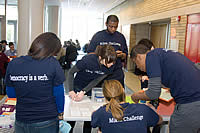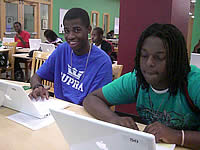Editor's note: In March 2009, WKCD wrote about the involvement of students from Chicago’s Mikva Challenge in citywide policy discussions about improving school safety. The youth sent a clear message: they want to be part of bringing positive change to Chicago Public Schools (CPS). This October, Mikva Challenge youth issued a new report that’s turning heads—on how CPS needs to overhaul its technology policy to catch up with the 21st Century. This article was first published in the Catalyst Notebook and is reprinted here with the permission of Catalyst Chicago.
by Taryn Tawoda, Catalyst Notebook
CHICAGO, IL—Most schools ban students from using cell phones at school, but teachers should realize that they have hidden potential as learning tools, says a recent report from the student-led Mikva Challenge Education Council.
To combat “outdated and unrealistic technology policies” in Chicago Public Schools, the council issued 18 recommendations on using technology to improve student performance.
Students on the 15-member council met with [Chicago public schools’] CEO Ron Huberman earlier this month to discuss their findings, kicking off what they hope will be an ongoing district-wide conversation on technology use in schools.
According to the report, CPS needs to overhaul its technology policy to catch up with the 21st Century. As it stands, students in CPS are barred from accessing YouTube videos and bringing cell phones to school, and teachers are not required to incorporate video or audio recordings in their lesson plans.
The council, organized by the Mikva Challenge, a non-profit that promotes civic engagement among young people in Chicago schools, insists that better access to technology can improve the “rigor, relationships and relevance of high schools” in an age where students’ computer abilities can affect their study habits, grades and future career opportunities.

“I don’t think anyone would say that technology is the solution, but there’s an obvious hole in the education system as it is right now,” says Jessica Gingold, who coordinates the council. “It’s a reality that we are living in a digital world, and schools need to start teaching students to be responsible digital citizens.”
The report, “Bringing Chicago Public High Schools into the 21st Century,” also recommends holding mandatory technology workshops for teachers, setting up Skype access for students who want to take a course offered at another school, and allowing students and teachers to use YouTube videos as learning aid—a policy that may be changed as early as this year, says Gingold.
 For inspiration, students visited VOISE Academy, a high school that features an online-only curriculum and uses technology to create a personalized learning environment, and YOUmedia, a center at Harold Washington Library that gives teens access to thousands of books and media tools via computers. They also surveyed 380 CPS students from 72 high schools to get a sense of where technology is lacking most.
For inspiration, students visited VOISE Academy, a high school that features an online-only curriculum and uses technology to create a personalized learning environment, and YOUmedia, a center at Harold Washington Library that gives teens access to thousands of books and media tools via computers. They also surveyed 380 CPS students from 72 high schools to get a sense of where technology is lacking most.
The report’s emphasis is not only on bringing more technology into the classroom, but on ensuring that teachers know how to use it to heighten students’ interest and enthusiasm during class. For example, the report suggests that students be allowed to look up words on a dictionary in their cell phone during class, and that teachers show YouTube videos demonstrating certain class concepts.
“Students can’t be experts in technology if they’re not allowed to use it at school, because that’s where they spend most of their time,” says Alex Marquez, a council member and a senior at John Hancock High School. “They have to be using it the right way, so the teacher should be implementing it the right way, too.”
In their meeting with Huberman, students also discussed making a city-wide video for CPS addressing cyber-bulling and sexting—two widespread problems spawning from heavy use of cell phones and the Internet by teens.
“I think there’s some definite momentum within CPS to take high schools to the 21st century, and I think the students have the capacity and passion to make a change happen,” says Gingold. “We want to work together to see that some of these recommendations become a reality.”
The Catalyst Chicago is an independent news magazine created in 1990 to document, analyze and support school-improvement efforts in the Chicago Public Schools. It is published by the Community Renewal Society (CRS), a nonprofit organization founded in 1882 that works to create racially and economically just communities.
Read WKCD’s 2009 feature story about the Mikva Challenge.





